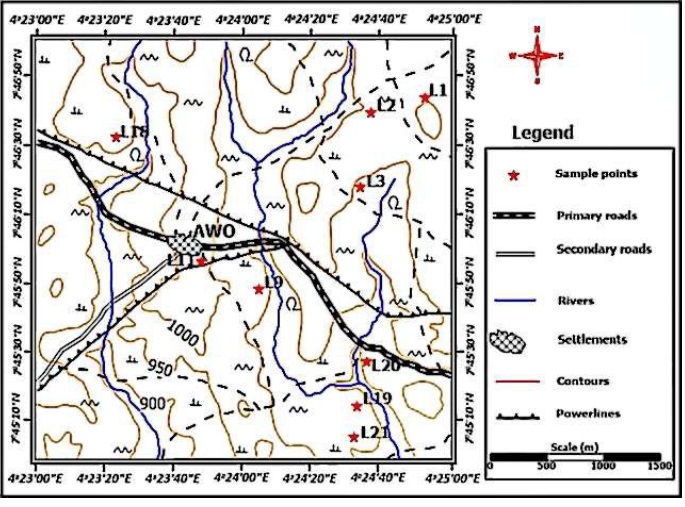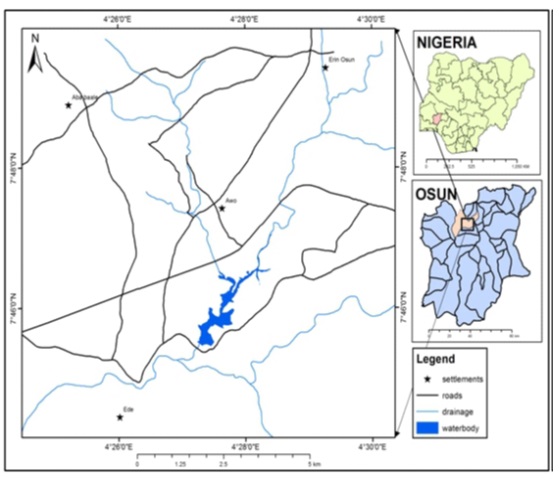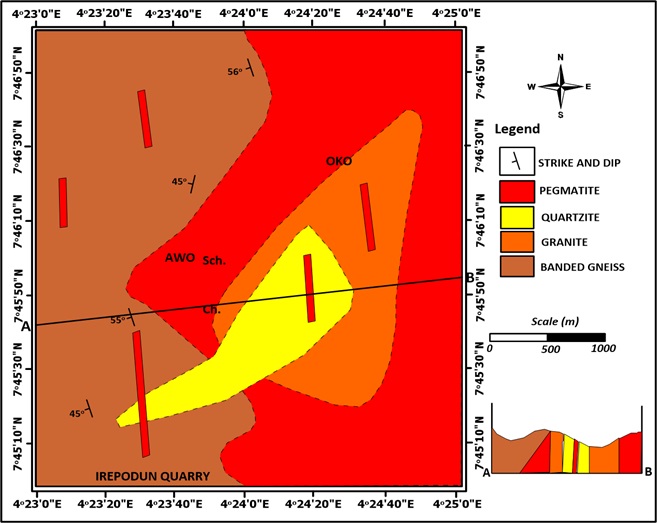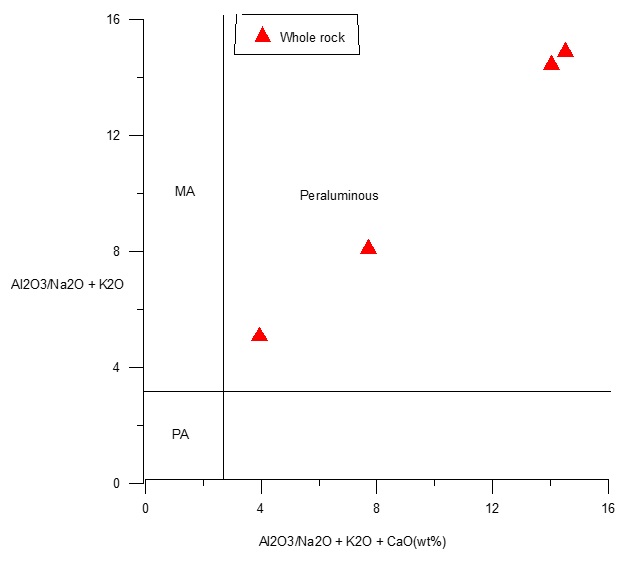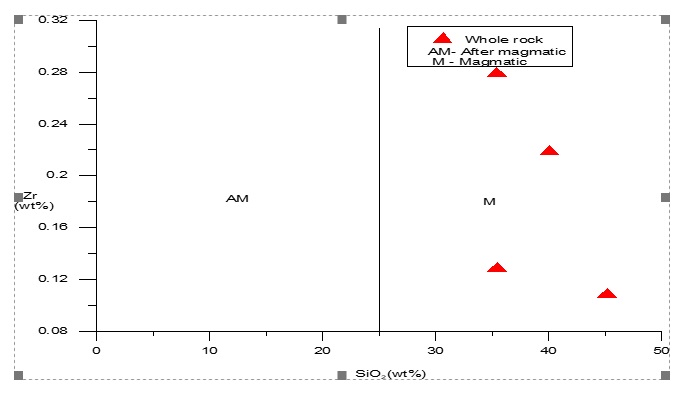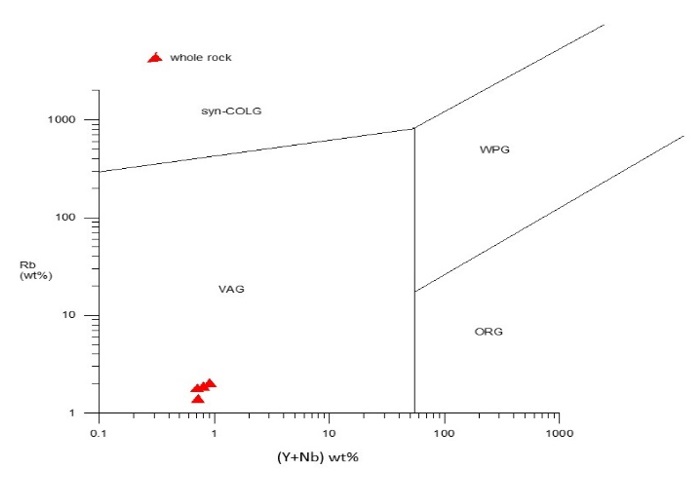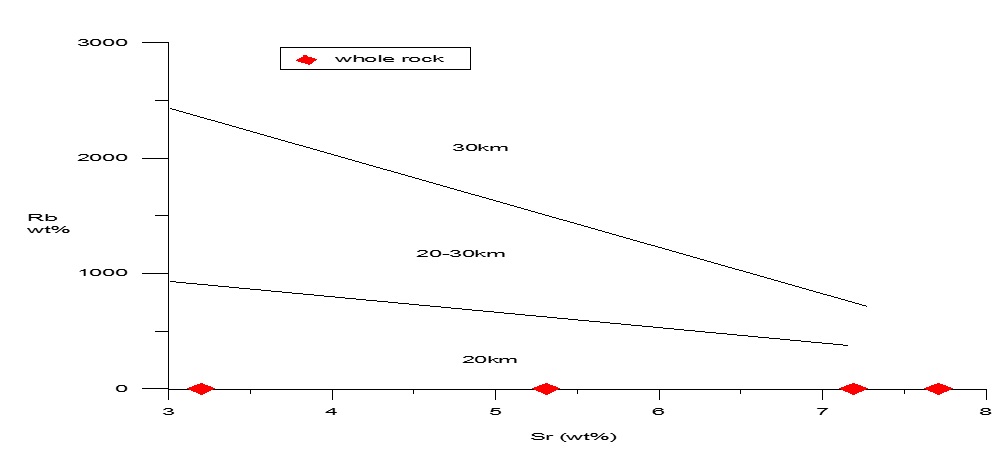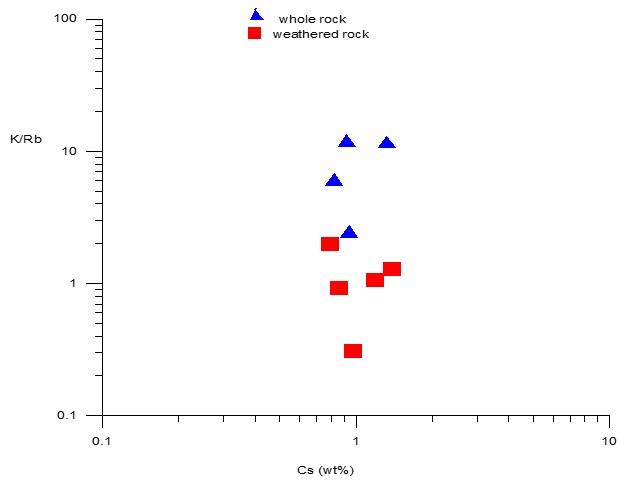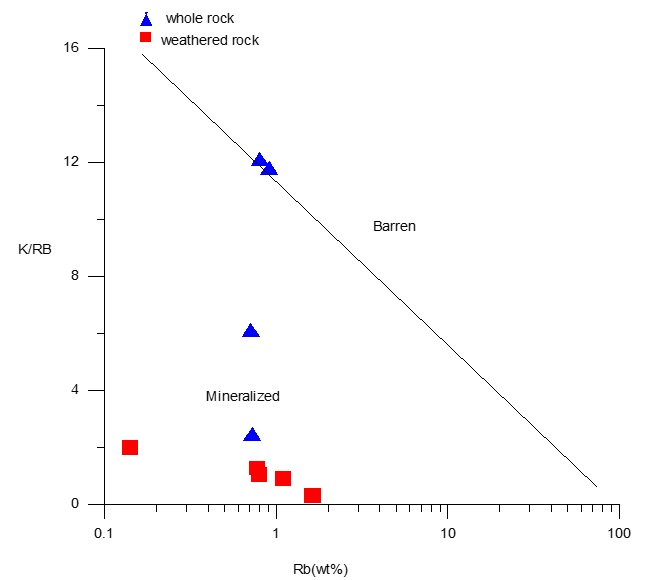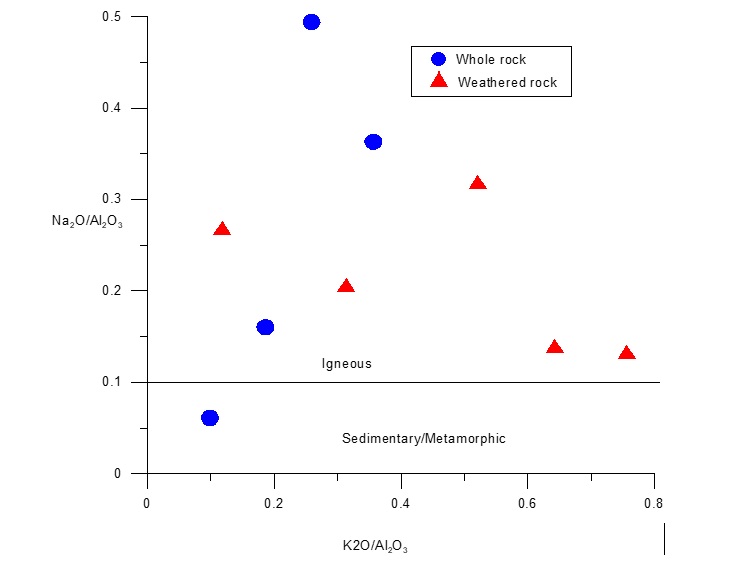Petrographic Studies, Geochemical Characterization and Mineralization Potential of Pegmatite at Awo, Southwestern Nigeria
- Folashade Ruth Adetunla
- O. Oshin
- 448-460
- Apr 18, 2024
- Environmental Impact
Petrographic Studies, Geochemical Characterization and Mineralization Potential of Pegmatite at Awo, Southwestern Nigeria
Folashade Ruth Adetunla and O. Oshin
Federal Polytechnic Ede and Ajayi Crowther University Oyo.
DOI: https://doi.org/10.51584/IJRIAS.2024.90341
Received: 26 February 2024; Revised: 12 March 2024; Accepted: 16 March 2024; Published: 18 April 2024
ABSTRACT
Pegmatites are known to host industrial minerals, rare metals and gemstones of economic values. They occur across various formations in Nigeria but mostly in granitoids and occur mostly as intrusions in Ilesha schist belt of which the study area is situated. The studies of petrography, geochemical characterization and mineralization potential of pegmatites at Awo, Southwestern Nigeria was carried out in order to classify and deduce the tectonic setting as well as the type of ore mineralization in the area. The study employed petrographic studies of nine pegmatite samples. Four whole pegmatite rock samples were analyzed using X-Ray Diffraction while Five tantalo-columbite ore samples and four whole rock samples were further analyzed using Energy Dispersive X-Ray Fluorescence. Petrographic studies of the Awo pegmatite showed quartz to range from 20.0% to 34.1%, microcline ranges from 20.6% to 44.7%, plagioclase play characteristic albite twinning and ranges from 14.8% to 23.2%, biotite ranges from 2.7% to 21.8%, hornblende ranges from 4.1% to 19.4% while muscovite ranges from 2.2% to 6.1%, with less than 1% accessory opaque minerals. X-ray diffraction results indicated that quartz ranges from 25% to 51% while feldspar is from 53% to 88% indicative of peraluminous composition of Awo pegmatites. Niobium oxide ranges from 2.86% to 5.29% while tantanium oxide ranges from 1.08% to 1.49% for whole pegmatite rock samples. Major oxides, trace and rare earth elements results show niobium oxide ranges from 24.76% to 31.43% while tantanium oxide ranges from 22.57% to 27.36% for ore samples, which revealed preference for niobium in pegmatite of the studied area. Awo pegmatite belongs to rare earth element class in NYF family as shown from progressive accumulation of Nb, Y and F from 0.63wt% to 1.22wt%, 0.61wt% to 1.00wt% and 0.27wt% to 0.73wt% respectively for whole rock samples as well as 15.62wt% to 21.40wt%, 0.45wt% to 0.85wt% and 0.28wt to 1.10wt% for ore samples. This pegmatite is of magmatic origin, peraluminous in composition from NYF family and the metal ore is columbite.
Keywords: Pegmatite, columbite, characterization, mineralization, Awo.
INTRODUCTION
Pegmatites are extremely slowly cooled igneous rocks resulting from the very last stage crystallization of magma, rich in volatiles and rare earth elements (King, 2016). Pegmatites are exceptionally coarse-grained intrusive. igneous rocks that can range in composition from mafic to granitic to syenitic. They occur as intrusions in many different geological settings usually as irregular masses, lenses, sills or dykes with sizes ranging from a few metres to many kilometres across (Arkenstone, 2016). Global study of pegmatite belts has increased because of its attractive economic potentials. Over the years as the government of Nigeria sought to reduce the country’s reliance on oil sector for economic growth, the tempo on the study of solid minerals has increased most especially study of pegmatite deposits because pegmatite are known as sources of gems (Simmons et al. 2012) and specialty metals as well as industrial minerals which include feldspar, quartz, mica and kaolin which are known to be deposited in most pegmatite. Many researchers have studied Nigerian pegmatites using different methodology (Anthony, 2022; Tanko and Dzigbodi-Adjimah, 2021; Tanko et al. 2020; Aderogbin and Okunlola, 2020; Omanayin et al. 2022).
Precambrian pegmatites of Nigeria are known to host a variety of rare earth metals, tantalum, niobium, tin, tungsten, columbium as well as lithium. More importantly, the tantalum and niobium contained in this specialty metals are used for heat and corrosion resistant steels and alloys applied in space ships and gas turbines. (Garba, 2003, Akintola, 2004, Okunlola, 2005, Okunlola and Jimba, 2006, Okunlola and Akintola, 2007, Okunlola and Akintola, 2008). Awo pegmatite occurrence which is part of the Precambrian pegmatites in Ibadan-Osogbo field was studied by Akinola et al. (2011) with the aim of elucidating their petrography and geochemical features and thus characterizing them, and understanding their genesis and rare metal potentials. This field is clearly enriched in Ta-Nb rare metal mineralization. The rare-metal content Ta-Nb is moderately high when compared with other mineralized pegmatites of Nigeria (Akinola et al. 2011).
There is increase in specification requirements for mineral products in the mineral market and the realization that mineral characterization can ensure optimization of mineral exploitation and thus maximizing profit. The growing need for detail information about the chemical composition of mineral deposit determines that mineral characterization studies form an integral and often critical part of investigations of mineral deposits. It is in view of these, that this work was conducted to investigate the mineralogical and geochemical characterization of pegmatites at Awo, Nigeria. This will enable probable investors determine whether Awo tantalo-columbite ore can meet existing market requirement, serve existing domestic and international usage thus enhance profit.
LOCATION AND ACCESSIBILITY
The study area lies within latitude 70 45‘ N to 70 47‘ N and longitude 40 23‘ E to 40 25′ E. It covers part of the topographic map sheet number 242 (Iwo N.E. 1:50,000) (Figure 1). Awo is situated on kilometer 75 along Iwo/Oshogbo road at Egbedore Local Government Osun State, Nigeria (Figure 2). The study area is generally accessible by complex road network of major and minor roads as well as foot path linking one sampling point to the other (Figure 2). The general drainage of the study area conforms to dendritic pattern. The land surface is generally undulating with high altitude in the northern part and low altitude in the southern parts of the basin. The drainage system here ranges from open water bodies to rivers, streams, wells, run-off waters and swamp. The drainage system is responsible for influencing the microclimate of the area together with other factors such as vegetation. Different land use patterns in the area include; farmlands, bushes, built up areas, swamps/wetlands, quarry areas and mines.
Figure 1: Digitized Topographical Map of the study area on a scale of 1:50,000 (Federal Surveys of Nigeria 1966, Sheet No. 242)
Figure 2: Map of Osun, Southwestern Nigeria showing the study area
GEOLOGY OF THE STUDY AREA
The basement complex of Nigeria is made up of Precambrian rocks and the schist belts folded into them. The basement rocks occupy about half of the land mass of the country, and is a part of the Pan-African mobile belt lying between the West African and Congo cratons (Ajibade and Fitches, 1988, and Black et al. 1994). According to the reports of Obaje (2009), the geology of Nigeria is made up of three major litho-petrological components, namely, the Basement Complex, Younger Granites, and Sedimentary Basins. Within the basement complex of Nigeria four major lithological units are distinguishable by Obaje (2009) namely: The Migmatite-Gneiss Complex, the Schist Belt (Metasedimentary and Metavolcanic rocks), the Older Granites (Pan African granitoids) and undeformed Acid and Basic Dykes. The study area is underlain by granite, banded gneiss and quartzite, with pegmatite trending in the NNW-SSE direction occurring as near vertical intrusions into the older rocks (Figure 3).
The granite occurs mostly in the northwestern portion of the map, the granites which are often coarse grained to porphyritic in texture are mainly composed of biotite, microcline and quartz.
The banded gneiss occurs as a massive rock consisting of alternating bands of felsic minerals notably plagioclase feldspars and quartz, and the dark bands consisting of biotite and hornblende. This rock extends from North to South at the Eastern part of the studied area.
The quartzite samples are mostly white in color but some ferruginized varieties display reddish bands. They consist mainly of quartz which occurs as irregular fine to medium grained crystals with interlocking grains of muscovite.
The pegmatite of Awo occur as near vertical intrusions covering the study area, the body intruded into granite, banded gneiss, and quartzite which are older rocks in the mapped area. They are coarse grained rock with a general milky white appearance which outcrops at the Northeastern part of the area. The main mineral assemblages are, quartz ranging from 20.0% to 34.1%, microcline ranges from 20.6% to 44.7%, plagioclase ranges from 14.8% to 23.2%, biotite ranges from 2.7% to 21.8%, hornblende ranges from 4.1% to 19.4% while muscovite ranges from 2.2% to 6.1%, and less than 1% accessory opaque minerals.
Figure 3: Digitized Geological Map of the study area
METHODS OF STUDY
Methods adopted for this research include field and laboratory operations. Detailed field procedure and traversing strategy were utilized to map the lithology of the area and enable sampling of fresh rocks at pre-designated points on the topographic map of scale 1: 50,000. A total of nine pegmatite samples were collected. Stream panning and magnetic identification were used to collect five tantalo-columbite ore minerals composed in the placer sediments of Awo study area. The samples were crushed separately into fragments with jaw crusher and pulverized using agate pestle and mortar, homogenized by sieving through 10 microns sieve. X-Ray Diffraction and X-Ray Fluorescence Spectrometry analyses of the samples were carried out at National Geosciences Research Laboratories (NGRL), Kaduna, nigeria and National Steel Raw Material Exploration Agency (NSRMEA), Kaduna, Nigeria respectively. Petrographic studies of rock samples were carried out to determine the average mineralogical composition of the rocks by studying the thin section of the samples under petrographic microscope with cross polarized light at the Geology Department, University of Ibadan, Nigeria.
RESULTS AND DISCUSSION
- Petrographic Studies
Average modal analysis of samples studied under the petrographic microscope are presented in Table 1.
Table 1: Average Modal Composition of Pegmatite in the Study Area
| SAMPLE NO | QUARTZ | MICROCLINE | PLAGIOCLASE | BIOTITE | HORNBLENDE | MUSCOVITE | OPAQUE | ROCK TYPE |
| L21 | 26.7 | 32.1 | 22.2 | 11.0 | 4.1 | 3.2 | 0.7 | Pegmatite |
| L1 | 21.1 | 20.6 | 20.6 | 17.8 | 16.1 | 3.0 | 0.8 | Pegmatite |
| L9 | 22.2 | 25.0 | 17.3 | 21.8 | 10.7 | 2.2 | 0.8 | Pegmatite |
| L11 | 20.0 | 22.4 | 18.3 | 16.1 | 19.4 | 3.1 | 0.7 | Pegmatite |
| L2 | 30.5 | 42.4 | 17.7 | 3.3 | 0 | 6.1 | 0 | Pegmatite |
| L3 | 28.5 | 40.7 | 23.2 | 3.1 | 0 | 4.5 | 0 | Pegmatite |
| L18 | 28.4 | 44.7 | 20.6 | 2.7 | 0 | 3.6 | 0 | Pegmatite |
| L20 | 34.1 | 42.7 | 14.8 | 3.7 | 0 | 4.7 | 0 | Pegmatite |
| L19 | 32.6 | 40.6 | 20.1 | 2.9 | 0 | 3.8 | 0 | Pegmatite |
Photomicrograph of pegmatite as shown in Figure 4 (a) and (b)
Note: Q means quartz, B is biotite, M is microcline, H is hornblende, P is plagioclase while MUS is muscovite.
The main mineral assemblages are, quartz ranging from 20.0% to 34.1%, it occurs as cloudy an-hedral grains with wavy extinction and characteristic weak birefringence. The graphical intergrowth of microcline which ranges from 20.6% to 44.7%, was observed, plagioclase play characteristic albite twinning and ranges from 14.8% to 23.2% biotite occur as fine dark brown platy grains ranging from 2.7% to 21.8%, hormblende ranges from 4.1% to 19.4% while muscovite exhibited elongated plates with high relief ranging from 2.2% to 6.1%, and less than 1% accessory opaque minerals (Table 1) (Figure 4 (a) and (b))
- X-Ray Diffraction Results
Results of four whole pegmatite rock samples analyzed from location 9, 11, 19 and 21 as presented in Table 2
| S/NO | LOCATION NO | QUARTZ SCORE | MICROCLINE SCORE | ALBITE SCORE | BIOTITE SCORE | QUARTZ SCALE FACTOR | MICROCLINE SCALE FACTOR | ALBITE SCALE FACTOR | BIOTITE SCALE FACTOR |
| 1. | Location 9 | 48 | 42 | 34 | 20 | 0.152 | 0.336 | 0.119 | 0.095 |
| 2. | Location 11 | 51 | 50 | 38 | 0.323 | 0.442 | 0.148 | ||
| 3. | Location 19 | 50 | 44 | 16 | 16 | 0.240 | 0.072 | 0.050 | 0.018 |
| 4. | Location 21 | 25 | 19 | 34 | 0.067 | 0.053 | 0.095 |
Silica content
The results in Table 2 indicated that quartz ranges from 25 counts to 51counts whereas feldspar ranges from 53 counts to 88 counts. This showed low percentage of silica content in Awo pegmatite which is suggestive of other source aside from granitic.
- X-Ray Fluorescence Results
Results of four whole pegmatite rock samples from location 9, 11, 19, 21and five tantalo-columbite ore mineral samples from location 1, 2, 3, 18 and 20 of placer sediments are presented in Tables 3(a) & (b) and 4 (a) & (b) respectively.
Table 3a: Major Oxides Results of Whole Pegmatite Rock Samples
| LOCATIONNO | SiO2 | SrO | K2O | Al2O3 | Nb2O5 | B2O3 | SnO2 | Cs2O | Rb2O | Fe2O3 | Na2O | Ta2O5 |
| L9 | 35.44 | 12.21 | 7.48 | 9.89 | 5.29 | 11.53 | 3.33 | 2.12 | 1.35 | 1.86 | 1.32 | 1.24 |
| L11 | 40.07 | 8.01 | 7.36 | 11.46 | 3.74 | 0.87 | 2.58 | 2.71 | 1.37 | 1.71 | 1.6 | 1.49 |
| L19 | 45.19 | 5.69 | 1.44 | 12.25 | 2.86 | 11.06 | 2.12 | 2.28 | 1.26 | 1.86 | 3.29 | 1.19 |
| L21 | 35.42 | 13.3 | 3.34 | 10.65 | 4.45 | 13.25 | 2.42 | 1.91 | 1.2 | 2.6 | 2.2 | 1.08 |
| LOCATIONNO | UO2 | TiO2 | PbO | MnO | ScO | SO2 | CaO | Y2O3 | MgO | ZrO | ThO2 | |
| L9 | 0.82 | 1.15 | 0.66 | 0.82 | 0.5 | 0.86 | 0.45 | 0.72 | 0.5 | 0.27 | 0.10 | |
| L11 | 6.06 | 0.86 | 0.5 | 0.67 | 0.69 | 1.01 | 0.49 | 1.03 | 0.67 | 0.4 | 0.11 | |
| L19 | 2.3 | 0.82 | 0.85 | 0.9 | 0.51 | 0.88 | 1.23 | 0.88 | 0.65 | 0.24 | 0.12 | |
| L21 | 1.96 | 0.84 | 0.63 | 1.16 | 0.56 | 0.45 | 0.48 | 0.86 | 0.56 | 0.58 | 0.06 |
Table 3b: Trace and Rare Earth Elements Results of Whole Pegmatite Rock Samples
| LOCATION NO | Si | Sr | K | Al | Nb | B | Sn | Cs | Rb | Fe | Na | Ta | U |
| L9 | 35.99 | 7.19 | 9.7 | 11.81 | 1.22 | 20.39 | 1.35 | 0.92 | 0.80 | 1.42 | 2.59 | 0.57 | 0.19 |
| L11 | 45.8 | 5.31 | 10.74 | 15.44 | 0.97 | 1.93 | 1.18 | 1.32 | 0.91 | 1.47 | 3.55 | 0.77 | 1.54 |
| L19 | 43.85 | 3.2 | 1.78 | 14.01 | 0.63 | 18.73 | 0.82 | 0.94 | 0.72 | 1.36 | 6.19 | 0.52 | 0.5 |
| L21 | 35.66 | 7.71 | 4.34 | 12.64 | 1.02 | 23.13 | 0.97 | 0.82 | 0.71 | 1.97 | 4.29 | 0.49 | 0.44 |
| LOCATION NO | Ti | Pd | Mn | Sc | S | Ca | Y | Mg | Zr | F | Th | ||
| L9 | 0.88 | 0.38 | 0.7 | 0.67 | 0.82 | 0.49 | 0.61 | 0.75 | 0.13 | 0.43 | 0.20 | ||
| L11 | 0.74 | 0.32 | 1 | 1.06 | 1.08 | 0.6 | 1 | 1.14 | 0.22 | 0.73 | 0.10 | ||
| L19 | 0.6 | 0.47 | 0.74 | 0.66 | 0.8 | 1.28 | 0.73 | 0.94 | 0.11 | 0.43 | 0.14 | ||
| L21 | 0.64 | 0.36 | 0.99 | 0.76 | 0.42 | 0.52 | 0.73 | 0.84 | 0.28 | 0.27 | 0.09 | ||
Table 4a: Major Oxides Results of Tantalo-columbite Ore Samples
| LOCATION NO | Ta2O5 | Nb2O5 | Fe2O3 | B2O3 | UO2 | MnO | SiO2 | Cs2O | ThO2 | SrO | SnO2 | Rb2O |
| L1 | 26.79 | 27.53 | 7.87 | 9.67 | 3.28 | 3.43 | 5.46 | 2.05 | 1.9 | 1.21 | 1.25 | 0.76 |
| L2 | 22.57 | 28.67 | 9.17 | 9.38 | 3.59 | 4.47 | 6.69 | 1.78 | 2.75 | 0.77 | 1.31 | 0.79 |
| L3 | 22.59 | 27.89 | 10.47 | 8.84 | 1.14 | 3.8 | 8.85 | 1.5 | 2.78 | 2.23 | 1.29 | 0.17 |
| L18 | 27.36 | 24.76 | 7.88 | 8.54 | 1.59 | 3.81 | 6.72 | 1.44 | 2.99 | 2.26 | 1.72 | 1.59 |
| L20 | 24.67 | 31.43 | 9.13 | 2.63 | 4.18 | 3.62 | 6.79 | 1.34 | 2.12 | 1.08 | 1.59 | 1.13 |
| LOCATION NO | TiO2 | Y2O3 | Al2O3 | K2O | SO2 | P2O3 | CaO | ZrO3 | MgO | Na2O | F | Ta |
| L1 | 1.09 | 0.79 | 0.94 | 0.49 | 0.8 | 0.9 | 0.5 | 0.4 | 0.4 | 0.3 | 1.1 | 11.56 |
| L2 | 0.87 | 0.75 | 0.85 | 0.42 | 1.02 | 0.18 | 0.24 | 1.08 | 0.29 | 0.22 | 1.45 | 9.58 |
| L3 | 0.64 | 0.7 | 2.95 | 0.18 | 1.95 | 0.37 | 0.48 | 0.3 | 0.48 | 0.29 | 1.23 | 7.61 |
| L18 | 0.92 | 0.54 | 1.56 | 0.25 | 1.61 | 0.98 | 0.28 | 0.24 | 0.46 | 0.29 | 1.22 | 11.75 |
| L21 | 1.02 | 1.06 | 1.46 | 0.53 | 1.21 | 0.06 | 0.36 | 1.31 | 0.5 | 0.52 | 0.28 | 10.11 |
Table 4b: Trace and Rare Earth Elements Results of Tantalo-columbite Ore Samples
| LOCATION NO | Nb | Fe | B | U | Mn | Si | Cs | Th | Sr | Sn | Rh | Rb |
| L1 | 19.74 | 9.4 | 26.48 | 1.16 | 4.62 | 8.67 | 1.39 | 0.69 | 1.11 | 0.79 | 0.91 | 0.77 |
| L2 | 20.24 | 10.77 | 25.27 | 1.25 | 5.86 | 10.45 | 1.19 | 0.98 | 0.7 | 0.82 | 0.8 | 0.79 |
| L3 | 15.62 | 9.61 | 33.22 | 0.31 | 3.99 | 10.96 | 0.79 | 0.78 | 1.6 | 0.64 | 0.43 | 0.14 |
| L18 | 17.68 | 9.37 | 23.28 | 0.56 | 5.09 | 10.61 | 0.97 | 1.08 | 2.07 | 1.09 | 0.83 | 1.62 |
| L20 | 21.4 | 10.35 | 22.05 | 1.4 | 4.62 | 10.23 | 0.86 | 0.83 | 0.94 | 0.96 | 0.87 | 1.09 |
| LOCATION NO | Ti | Y | Pd | Al | Sc | K | S | P | Ca | Zr | Mg | Na |
| L1 | 1.3 | 0.62 | 0.49 | 1.75 | 1.01 | 0.99 | 1.18 | 1.21 | 0.85 | 0.31 | 0.95 | 0.93 |
| L2 | 1.02 | 0.63 | 0.42 | 1.57 | 1.07 | 0.84 | 1.5 | 0.24 | 0.4 | 0.82 | 0.67 | 0.67 |
| L3 | 0.6 | 0.46 | 0.3 | 4.3 | 0.79 | 0.28 | 2.27 | 0.39 | 0.63 | 0.18 | 0.89 | 0.7 |
| L18 | 1.09 | 0.45 | 0.55 | 2.9 | 0.98 | 0.5 | 2.39 | 1.31 | 0.48 | 0.19 | 1.08 | 0.88 |
| L20 | 1.16 | 0.85 | 0.47 | 2.6 | 0.88 | 1.01 | 1.71 | 0.07 | 0.59 | 0.96 | 1.12 | 1.53 |
Table 5: K/Rb Ratio Results of Whole Pegmatite Rock and Ore Samples
| Location No | K/Rb ratio for whole rock (ppm) | Location No | K/Rb ratio for ore from weathered rock (ppm) |
| L9 | 121,250 | L1 | 12,857 |
| L11 | 118,022 | L2 | 10,632 |
| L19 | 24,722 | L3 | 20,000 |
| L21 | 61,126 | L18 | 3,086 |
| L20 | 9,266 |
3.1 Peraluminous composition
Awo pegmatite have high values of aluminous and are of peraluminous bulk composition as shown from the discriminant plot of Al2O3/Na2O+ K2O against Al2O3/Na2O+K2O-CaO on a bivariate plot (see Figure 5). This could be the result of parent melt having another aluminous phase present such as aluminous biotite or muscovite and garnet (Frost et al. 2001).
Figure 5: Plot of Al2O3(Na2O + K2O) (wt%) against Al2O3 (Na2O + K2O – CaO) (wt%) showing the peraluminous nature of the pegmatites in the study area after Maniar and Piccoli, (1989)
3.2 Magmatic Origin
The plot of Zr/SiO2 (Figure 6) reveals all samples plotted in magmatic “M” field. High concentration of Rb in the studied rock than the normal content Rb (150ppm) (Taylor, 1965) is suggestive of very high degree of partial melting of the parent rock which affirmed that pegmatite in the study area has magmatic origin.
Figure 6: Plot of Zr (wt%) against Si2O (wt%) after Moller and Morteani, (1987)
3.3 Volcanic Arc Granite
On the Rb versus Y+Nb diagram (Figure 7), samples plot in the field of volcanic arc granites while crustal thickness during emplacement of these pegmatite bodies as shown from the Rb/Sr plot of Condie (1976) (Figure 8) does not exceed about 20km.
Figure 7: Rb (wt%) against (Y + Nb) wt% Discrimination Diagram after Pearce et al. (1984)
NOTE: VAG – volcanic arc granite, WPG – within plate granite, ORG- oceanic ridge granite
Figure 8: Plot of Rb (wt%) against Sr (wt%) after Condie (1976).
3.4 Mineralisation potentials of Awo Pegmatite
Mineralization potential trend as shown from plots of K/Rb versus Cs (Figure 9), and K/Rb versus Rb (Figure 10) suggest a consistent trend as more than 80% of the samples plotted in the mineralized field (Moller and Morteani, 1987). The high value of Cs (Figure 9) is suggestive of high REE metal fractionation (Cerny, 1982,1989). Chondritic normalized diagram (Figure 11) also suggest mineralization with prolong interaction between the magmatic fluid and host rock Piper (1974) and Garba (2003).
Figure 9: Plot of K/Rb (wt%) against Cs showing Metal Fractionation after Cerny (1982)
Figure 10: Plot of K/Rb (wt%) against Rb (wt%) after Moller and Morteani, (1987)
Figure 11: Chondritic normalized plot of the pegmatite samples modelling and resembling mineralization with prolong interaction between the magmatic fluid and host rock (Piper, 1974 and Garba, 2003).
3.5 Rare Element of NYF family
Pegmatite classification according to Černý and Ercit, (2005) suggests that Awo pegmatite belong to rare earth element class in NYF family with progressive accumulation of Nb, Y and F besides REE, Sc, Ti, Zr, Th and U. Increase in the value of Nb, Y and F from 0.63 wt% to 1.22 wt%, 0.61 wt% to 1.00 wt% and 0.27 wt% to 0.73 wt% respectively for whole rock while Nb, Y and F recorded 15.62 wt% to 21.40 wt%, 0.45 wt% to 0.85 wt% and 0.28 wt to 1.10 wt% for ore samples showed progressive accumulation of Nb, Y and F which suggested that Awo pegmatite belong to REE class in NYF family.
This study has shown that there is geochemical evidence of internally derived mineralizing fluids, such as fluid fractionation, which has modified ratios, such as K/Rb and (Table 5). These have been used to explain fractionation of other rare metal pegmatites (Pan, 1997; Linnen, 1998; Dostal and Chatterjee, 2000; Linnen and Keppler 2002). Trace and rare earth element data (Tables 3 and 4) show that Awo pegmatite is enriched in rare metals with moderately high values of Cs, Nb, Sn, Rb, and Ta. There is considerable F content (0.27 wt% to 0.73 wt%) in pegmatite samples analyzed. Even at low concentrations, fluorine may influence fractionation of REE and the transition elements (Linnen, 2012)
CONCLUSION
Results of this study showed that the Precambrian pegmatite of Awo which intruded the banded gneiss, quartzite and granite are rare-metal pegmatites. Microcline and albite are the dominant feldspars with subordinate quartz and biotite. Awo pegmatite belong to rare earth element class in NYF family as shown from progressive accumulation of Nb, Y and F besides REE, Sc, Ti, Zr, Th and U. This field is clearly enriched in Nb-Ta rare metals. Mineralization potential trend suggested a consistent trend as almost 80% of the samples plotted in the mineralized field. The plots of Zr versus SiO2 revealed Awo pegmatite is in magmatic “M” field. High concentration of Rb in the studied whole pegmatite rocks than the normal Rb content is suggestive of very high degree of partial melting of the parent rock which affirmed that pegmatite in the studied area has magmatic origin. The Rb versus Y+Nb diagram suggested volcanic arc granites while crustal thickness during emplacement of these pegmatite bodies does not exceed about 20km.
REFERENCES
- Aderogbin, J. A. and Okunlola, O. A. (2020). Compositional Characteristics and Ta-Sn-Nb Rare Metal Mineralization Potential of Egbe Pegmatite, Southwestern Nigeria. Global Journal of Geological Sciences, Vol. 18, 2020: 49-62. ISSN 1596-6798. Org/10.4314/Gjgs.V18i1.5
- Akintola, A.I., Omosanya, K.O., Ajibade, O.M., Okunlola, O.A., and Kehinde-Phillips, O.O. (2011). Petrographic and geochemical evaluations of rare-metal (Ta-Nb) potentials of Precambrian pegmatites of Awo Area, Southwestern Nigeria. IJBAS-IJENS 11 (4), 78e95. 101, 635e643.
- Akintola, A. I., Ikhane, P. R., Okunlola, O. A., Akintola, G. O., and Oyebolu, O. O. (2012). Geochemical features of the Precambrian Pan–African Pegmatites of Ijebu–Ife Area, Southwestern Nigeria. Environment, Ecology & Management Journal (1), 38–
- Anthony, Chukwu (2022). Characterization of Mineralized Pegmatites around Wowyen Areas, Akwanga, North central Nigeria. Advances in Geological and Geotechnical Engineering Research, Vol. 04 (01), pp. 37 –
- Arkenstone, T. (2016). What are Pegmatite Minerals? Retrieved from the Arkenstone.iRocks.com: http://www.irocks.com/whats-the-deal-with-pegmatites-fineminerals-rocks
- Černý, P. (1975). Granitic pegmatites and their minerals: selected examples of recent progress. Miner.52, 225–250.
- Černý, P. (1982). Granitic Pegmatites in Science and Industry. Mineralogical Association of Canada Short. Course Handbook 8, 555 p.
- Condie, K.D. (1976). Trace element geochemistry of Archean granite rocks from the Barberton Region, South Africa, AM. Mineral. Earth Planet Sc. Letter, pp.300-400.
- Garba, I. (2003). Geochemical discrimination of newly discovered rare metal bearing and barren pegmatites in the Pan-African 600 ± 150 Ma basement of northern Nigeria. Applied Earth Sciences Transaction Institute of Mining and Metallurgy, 112 (13), 287 –
- King, H. (2016). Pegmatites. Retrieved from geology.com:http://geology.com/rocks/pegmatite.shtml
- Linnen, R. L. (1998). The solubility of Nb-Ta-Zr-Hf-W in granitic melts with Li and Li + F: Constraints for mineralization in rare-metal granites and pegmatites. Econ. Geol. 93, 1013-1025.
- London, D. and Morgan, G. B. (2004). Alkali fractionation and feldspar zonation in granitic pegmatites. Geological Society of America Abstracts with Programs 36: 46
- Maniar, P.D. and Piccoli, P.M. (1989). Tectonic discrimination of granitoids. Geol. Soc. Am. Bull. 101, 635e643.
- Moller, P and Morteani, G. (1987). Geochemical exploration guide for Tantalum pegmatites. Economic Geology, Vol.42, pp. 1885-1897.
- Morteani, G., Prienfalk, G. and Burt, A.H., (2000). Classification and mineralization potential of the pegmatites of the eastern Brazilian pegmatite province. Miner. Deposita 35, 638e655.
- Obaje, N. G. (2009). Geology and Mineral Resources of Nigeria. Springer Science, 221p. http://dx.doi.org/10.1007/978-3-540-92685-6
- Omanayin, Y. A., Waziri, N. M., Onoduku, U. S., Alabi, A. A., and Amadi, A. N. (2022): Geology and geochemistry of pegmatites of Ogodo-Odobola, North central Nigeria. FUDMA Journal of Sciences (FJS) Vol. 6 No. 6, December, 2022, pp 15 – 21.
- Okunlola, O.A. (2005). Metallogeny of Tantalite-Niobium Mineralization of Precambrian Pegmatites of Nigeria. Mineral Wealth; 104/2005, pp. 38-50.
- Okunlola, O.A. and Jimba, S. (2006). Compositional trends in relation to Ta-Nb mineralization in Precambrian pegmatites of Aramoko-Ara-Ijero area, southwestern Nigeria. Journal of Mining Geology Vol. 42(2), pp. 113-126.
- Olade, M.A. and Elueze, A. A. (1979). Petrochemistry of the Ilesha amphibolite and Precambrian crustal evolution in the Pan-African domain of SW Nigeria. Res. 8,303-318.
- Simmons, W.B, Webber, K.L., Falster, A.U. and Nizamoff, J.W. (2012). Pegmatology: Pegmatite mineralogy, petrology &petrogenesis. Rubellite Press, New Orleans, 176 p.
- Tanko, I. Y. and Dzigbodi-Adjimah, K. (2021). Geochemistry and Petrogenetic Relationships Between Pegmatites and Host Rocks in the Keffi Area, North Central, Nigeria. European Journal of Engineering and Technology Research (EJERS), Vol. 6, No. 2.
- Tanko, I. Y., Jatau, B.S., and Usman, H.O. (2020). Petrography, Geochemistry and Mineralisation Potential of the Pegmatites of Janjala Area, North Central Nigeria. International Research Journal of Natural Sciences, Vol. 8, No. 2, pp.34-51. Published by ECRTD-UK. Print:
- Taylor, S.R., Rudnick, R.L., McLennan, S.C and Eriksson, K.A. (1986). Rare earth element patterns in Archean high-grade metasediments and their tectonic significance. Cosmochim. Acta, 50, pp. 2267-2279.

